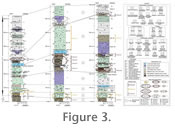Materials and Methods
 Three stratigraphically equivalent sections that span the entire (Ash-IV and pre-Ash-IV strata) sequence of volcaniclastic strata exposed along the Margargaria River were excavated, sampled, and described in detail (Figure 3). These range in thickness from 6.31 (southernmost) to 7.01 meters (northernmost), and represent a total lateral distance of approximately 30 meters. A total of 80 sedimentary layers were described among these three sections based on sedimentology, lithology, distribution of plant macrofossils, and paleosols (Figure 3). Based upon observable differences in bedding, grain size distribution, texture, sedimentary structures, biogenic structures, and fossil content, these 80 sedimentary layers were assigned to seven different depositional units (A-G). Complementary data about the mineralogy of the sediments of the different depositional units were obtained from petrographic analysis of thin sections following established methods (Moorhouse 1959). In addition, the mineralogical composition of host matrix sediments for strata representative of the different depositional units was determined by X-ray diffraction analysis of powdered samples using a Rigaku Ultima III X-ray diffraction system equipped with CuKá radiation (Moore and Reynolds 1997). Data were collected over 2-70° 2è in continuous scanning mode at 1° 2è/min, 30mA and 40 kV.
Three stratigraphically equivalent sections that span the entire (Ash-IV and pre-Ash-IV strata) sequence of volcaniclastic strata exposed along the Margargaria River were excavated, sampled, and described in detail (Figure 3). These range in thickness from 6.31 (southernmost) to 7.01 meters (northernmost), and represent a total lateral distance of approximately 30 meters. A total of 80 sedimentary layers were described among these three sections based on sedimentology, lithology, distribution of plant macrofossils, and paleosols (Figure 3). Based upon observable differences in bedding, grain size distribution, texture, sedimentary structures, biogenic structures, and fossil content, these 80 sedimentary layers were assigned to seven different depositional units (A-G). Complementary data about the mineralogy of the sediments of the different depositional units were obtained from petrographic analysis of thin sections following established methods (Moorhouse 1959). In addition, the mineralogical composition of host matrix sediments for strata representative of the different depositional units was determined by X-ray diffraction analysis of powdered samples using a Rigaku Ultima III X-ray diffraction system equipped with CuKá radiation (Moore and Reynolds 1997). Data were collected over 2-70° 2è in continuous scanning mode at 1° 2è/min, 30mA and 40 kV.
Paleosols were distinguished based on organic matter content, soil structure and mineralogy, mottling, horizonation, and color (Retallack 1988;
Mack et al. 1993;
Tabor et al. 2002). The fossils discussed herein were collected from layers distributed among the three geological sections (Figure 3). Geological section CH-79 was collected more intensively, preferentially collecting potentially identifiable specimens rather than every fossil fragment. Plant macrofossils were identified by comparisons with published modern reference materials and use of a variable pressure SEM and standard light microscopy. The total number of specimens from each section (CH-79=247, CH-93=68, CH-89=47) represents a minimum number because most samples (i.e., rocks) contain more than one leaf, megaspore, or other plant part of the same or different taxa.
